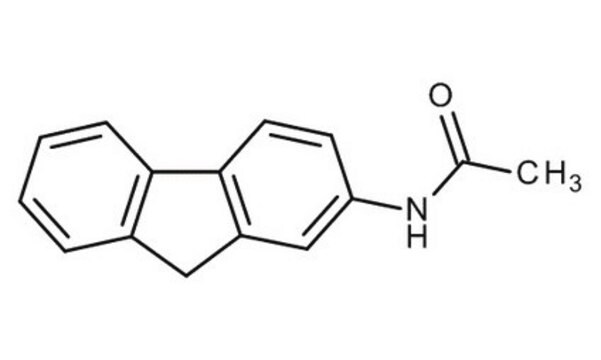A7015
N-(2-Fluorenyl)acetamide
≥98% (HPLC)
Sinônimo(s):
2-AAF, 2-Acetamidofluorene, N-Acetyl-2-aminofluorene
About This Item
Produtos recomendados
Ensaio
≥98% (HPLC)
Formulário
powder
pf
192-196 °C (lit.)
cadeia de caracteres SMILES
CC(=O)Nc1ccc-2c(Cc3ccccc-23)c1
InChI
1S/C15H13NO/c1-10(17)16-13-6-7-15-12(9-13)8-11-4-2-3-5-14(11)15/h2-7,9H,8H2,1H3,(H,16,17)
chave InChI
CZIHNRWJTSTCEX-UHFFFAOYSA-N
Procurando produtos similares? Visita Guia de comparação de produtos
Aplicação
Ações bioquímicas/fisiológicas
Palavra indicadora
Danger
Frases de perigo
Declarações de precaução
Classificações de perigo
Acute Tox. 4 Oral - Carc. 1B
Código de classe de armazenamento
6.1C - Combustible acute toxic Cat.3 / toxic compounds or compounds which causing chronic effects
Classe de risco de água (WGK)
WGK 3
Ponto de fulgor (°F)
Not applicable
Ponto de fulgor (°C)
Not applicable
Equipamento de proteção individual
Eyeshields, Gloves, type P2 (EN 143) respirator cartridges
Escolha uma das versões mais recentes:
Já possui este produto?
Encontre a documentação dos produtos que você adquiriu recentemente na biblioteca de documentos.
Artigos
DNA damage and repair mechanism is vital for maintaining DNA integrity. Damage to cellular DNA is involved in mutagenesis, the development of cancer among others.
Nossa equipe de cientistas tem experiência em todas as áreas de pesquisa, incluindo Life Sciences, ciência de materiais, síntese química, cromatografia, química analítica e muitas outras.
Entre em contato com a assistência técnica





